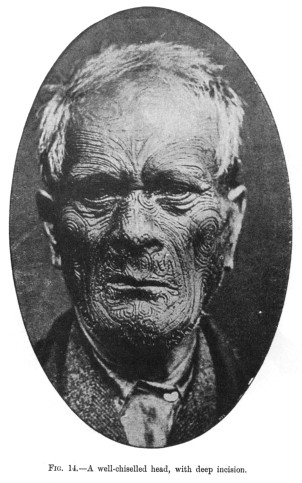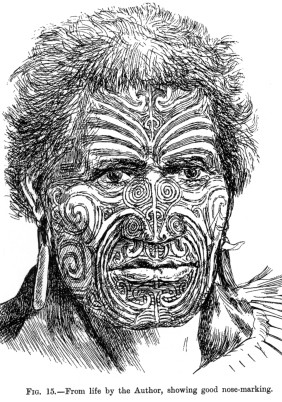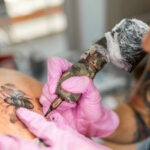Mike Tyson’s face tattoo is iconic; a symbol of strength and intrigue. At tattooat.com, we delve into the story behind this distinctive piece, exploring the cultural influences, artistic choices, and personal significance that make it so captivating. Discover the world of tattoos and find inspiration for your own body art journey! We also cover tattoo design ideas, the tattoo application process, and body art inspiration.
1. What Inspired Mike Tyson’s Face Tattoo?
The inspiration behind Mike Tyson’s face tattoo is rooted in a blend of cultural appreciation and personal symbolism. According to reports, In 2003, Mike Tyson got a tribal tattoo on the left side of his face designed by Victor Whitmill, a tattoo artist in Las Vegas. The tattoo is often mistaken as a Māori tribal design, but Whitmill has stated that it is actually an original design based on various tribal patterns.
- Māori Influences: While often mistaken for a traditional Māori moko, the design incorporates elements reminiscent of tribal patterns and their significance.
- Warrior Spirit: Tyson has spoken about the tattoo representing his warrior spirit, a visual manifestation of his resilience and strength.
- Personal Meaning: Beyond cultural references, the tattoo holds personal meaning for Tyson, reflecting his journey, struggles, and transformation.
2. Who Designed Mike Tyson’s Famous Face Tattoo?
Mike Tyson’s famous face tattoo was designed by Victor Whitmill. Whitmill is a skilled tattoo artist based in Las Vegas. Whitmill is known for his expertise in tribal and intricate tattoo designs.
- Collaboration: Tyson and Whitmill collaborated on the design. They ensured it reflected Tyson’s vision and personal story.
- Copyright Controversy: Whitmill later pursued legal action against Warner Bros. for replicating the tattoo in “The Hangover Part II.” This highlighted the complexities of tattoo copyright.
3. What Is The Meaning Behind Mike Tyson’s Tattoo Design?
The meaning behind Mike Tyson’s tattoo design is multi-layered, encompassing themes of identity, strength, and cultural appreciation. According to Tyson, the tattoo represents his “warrior status.” It symbolizes his personal battles and triumphs.
- Tribal Symbolism: The design draws inspiration from various tribal patterns. These patterns often represent protection, power, and connection to ancestral roots.
- Personal Transformation: For Tyson, the tattoo signifies a personal transformation. It embodies his journey from a controversial figure to a symbol of resilience.
- Visual Statement: The prominent placement of the tattoo makes a bold visual statement. It challenges conventional perceptions of beauty and identity.
4. How Did Mike Tyson Choose His Face Tattoo Design?
Mike Tyson chose his face tattoo design through a combination of personal reflection and artistic collaboration. According to an interview, Tyson initially wanted to get a heart tattoo with his then-wife’s name on it. However, he changed his mind at the last minute.
- Spontaneity: The decision to get the tattoo was somewhat spontaneous, reflecting Tyson’s impulsive nature at the time.
- Cultural Research: Tyson explored different cultural symbols and designs, seeking one that resonated with his personal narrative.
- Trust in the Artist: Tyson placed his trust in Victor Whitmill’s artistic vision. This allowed for a collaborative process that resulted in the final design.
5. What Was The Public Reaction To Mike Tyson’s Face Tattoo?
The public reaction to Mike Tyson’s face tattoo was mixed. It ranged from admiration to criticism. The tattoo has significantly impacted popular culture. According to media reports, some viewed it as a symbol of strength and individuality. Others criticized it as a sign of recklessness.
- Media Frenzy: The tattoo generated significant media attention. It sparked debates about cultural appropriation, body art, and personal expression.
- Fashion Statement: Despite the controversy, the tattoo influenced fashion and tattoo trends. Many people sought similar designs, inspired by Tyson’s bold choice.
- Enduring Icon: Over time, the tattoo has become an enduring icon. It is synonymous with Mike Tyson’s image and persona.
6. Has Mike Tyson Ever Regretted Getting His Face Tattoo?
Mike Tyson has expressed no regrets about getting his face tattoo. The tattoo remains a significant part of his identity. According to Tyson, he sees it as a reminder of his past. It also symbolizes his personal growth.
- Acceptance: Tyson has embraced the tattoo as a part of his story. He acknowledges that it reflects a specific period in his life.
- Symbol of Strength: The tattoo continues to represent strength and resilience for Tyson. These are qualities he values and embodies.
- Personal Choice: Tyson defends his decision as a personal choice. He encourages others to express themselves authentically.
7. How Does Mike Tyson’s Tattoo Reflect His Personality?
Mike Tyson’s tattoo reflects his personality through its boldness, complexity, and layers of meaning. The tattoo is a direct reflection of Tyson’s persona.
- Rebellious Spirit: The tattoo embodies Tyson’s rebellious spirit. It defies societal norms and expectations.
- Complex Identity: The design reflects the complexity of Tyson’s identity. It showcases his multifaceted nature as an athlete, celebrity, and individual.
- Inner Strength: The tattoo symbolizes the inner strength that Tyson has cultivated throughout his life. This strength has helped him overcome numerous challenges.
8. What Impact Did Mike Tyson’s Tattoo Have On Tattoo Culture?
Mike Tyson’s tattoo had a significant impact on tattoo culture, popularizing face tattoos and tribal designs. According to tattoo artists, the design inspired many people to explore body art as a form of self-expression.
- Acceptance of Face Tattoos: Tyson’s tattoo helped normalize face tattoos. It challenged the stigma associated with visible body art.
- Tribal Trend: The design sparked a trend in tribal-inspired tattoos. Many people sought similar patterns to connect with their heritage or express their personal beliefs.
- Artistic Freedom: Tyson’s bold choice encouraged others to embrace artistic freedom. They could express themselves through unique and unconventional tattoo designs.
9. What Are Some Interesting Facts About Mike Tyson’s Tattoo?
There are several interesting facts about Mike Tyson’s tattoo that contribute to its iconic status. In 2003, Mike Tyson got a tribal tattoo on the left side of his face designed by Victor Whitmill, a tattoo artist in Las Vegas.
- Last-Minute Decision: Tyson originally intended to get a different tattoo. However, he changed his mind at the last minute.
- Copyright Lawsuit: The tattoo artist, Victor Whitmill, sued Warner Bros. for replicating the design in “The Hangover Part II”.
- Cultural Misconceptions: The tattoo is often mistaken for a traditional Māori moko. It is actually an original design inspired by various tribal patterns.
10. Where Can I Find More Information About Tattoo Art And Culture?
You can find more information about tattoo art and culture at tattooat.com. The website provides a wealth of resources for tattoo enthusiasts. These resources include design ideas, artist profiles, and cultural insights.
- Extensive Database: tattooat.com offers an extensive database of tattoo designs. This allows users to explore various styles, themes, and inspirations.
- Artist Spotlights: The website features spotlights on talented tattoo artists. These artists showcase their work and share their unique perspectives.
- Educational Articles: tattooat.com provides educational articles. These articles cover the history, techniques, and cultural significance of tattoos.
 Mike Tyson's Iconic Face Tattoo
Mike Tyson's Iconic Face Tattoo
11. Exploring the Origins of Tribal Tattoos
Tribal tattoos, like the one adorning Mike Tyson’s face, have deep roots in various indigenous cultures around the world. These designs often carry significant cultural and spiritual meanings. According to anthropologists, tribal tattoos serve as markers of identity, status, and belonging within a community.
11.1. Māori Tattoos: A Closer Look
Māori tattoos, known as “moko,” are a sacred art form that reflects an individual’s genealogy, accomplishments, and social standing. Traditional Māori tattoos cover the face with intricate spirals and patterns carved into the skin using chisels. According to Dr. Ngahuia Te Awekotuku, a leading expert on Māori art, “Moko is a visual language that tells the story of a person’s life, their ancestors, and their connection to the land.”
11.2. Other Tribal Tattoo Traditions
Besides Māori tattoos, many other cultures have rich traditions of tribal body art.
- Samoan Tattoos: Known as “tatau,” Samoan tattoos are intricate designs that cover the body. They symbolize courage, strength, and commitment to community.
- Borneo Tattoos: Indigenous tribes in Borneo use tattoos to mark important life events. These events can include rites of passage, healing rituals, and spiritual protection.
- Haida Tattoos: The Haida people of the Pacific Northwest incorporate intricate designs. These designs often include animals, crests, and ancestral figures to signify clan membership and heritage.
12. The Controversy Surrounding Cultural Appropriation
Mike Tyson’s face tattoo has sparked discussions about cultural appropriation. This highlights the importance of understanding the origins and significance of tribal designs. According to cultural critics, appropriating cultural symbols without proper understanding or respect can be offensive. It can also perpetuate harmful stereotypes.
12.1. Respectful Appreciation vs. Appropriation
When choosing a tribal tattoo design, it is essential to differentiate between respectful appreciation and cultural appropriation.
- Research and Education: Take the time to research the history, meaning, and cultural context of the design.
- Consultation with Experts: Seek guidance from cultural practitioners or experts who can provide insights into the proper use of the design.
- Personal Connection: Choose a design that resonates with your personal values and beliefs. Ensure that it does not disrespect the cultural heritage it represents.
12.2. The Role of Tattoo Artists
Tattoo artists have a responsibility to educate their clients about the cultural significance of tribal designs. They should also ensure that they are not perpetuating cultural appropriation. According to tattoo artist and cultural advocate, Maya Schmidt, “As tattoo artists, we have a duty to honor the traditions and stories behind the designs we create. We need to approach tribal tattoos with humility, respect, and a commitment to cultural sensitivity.”
13. The Legal Battle Over Tattoo Copyright
The replication of Mike Tyson’s face tattoo in “The Hangover Part II” led to a legal battle over tattoo copyright. This case raised important questions about the ownership and intellectual property rights associated with tattoos. According to legal experts, tattoos can be protected under copyright law as original works of art.
13.1. Victor Whitmill vs. Warner Bros.
In 2011, tattoo artist Victor Whitmill sued Warner Bros. for copyright infringement, claiming that the studio had replicated his tattoo design without permission. The case was eventually settled out of court. It set a precedent for the legal protection of tattoos as intellectual property.
13.2. Implications for Tattoo Artists and Clients
The legal battle over Mike Tyson’s tattoo has significant implications for tattoo artists and clients.
- Ownership Rights: Tattoo artists retain ownership rights to their original designs. Clients may need to obtain permission or licensing agreements to replicate or reproduce the tattoo in commercial contexts.
- Creative Control: Tattoo artists have the right to control how their designs are used and distributed. This protects their artistic integrity and prevents unauthorized exploitation of their work.
- Legal Protection: Tattoo artists can pursue legal action against individuals or companies that infringe on their copyright. This helps safeguard their creative works.
14. Exploring Different Styles of Face Tattoos
Face tattoos have gained popularity in recent years, with individuals embracing various styles and designs to express their unique identities. While Mike Tyson’s tribal tattoo remains iconic, many other approaches to face tattoos offer diverse aesthetic and symbolic possibilities.
14.1. Geometric Patterns
Geometric face tattoos feature precise lines, shapes, and patterns that create visually striking compositions. These designs often symbolize harmony, balance, and mathematical perfection. According to tattoo artist and geometric specialist, Alex Rossi, “Geometric tattoos are about creating visual harmony and order on the skin. They can be both abstract and meaningful, reflecting the wearer’s connection to the universe and its underlying principles.”
14.2. Dotwork Tattoos
Dotwork tattoos involve creating designs using tiny dots of ink, resulting in a textured and intricate appearance. These tattoos often require patience and precision, but they can produce stunning visual effects. According to dotwork artist, Sarah Lee, “Dotwork tattoos are a meditation in ink. They require focus, attention to detail, and a deep appreciation for the art of creating something beautiful one dot at a time.”
14.3. Watercolor Tattoos
Watercolor tattoos mimic the fluid and translucent qualities of watercolor paintings, creating soft and ethereal designs. These tattoos often feature vibrant colors, delicate gradients, and artistic brushstrokes. According to watercolor tattoo artist, Emily Carter, “Watercolor tattoos are about capturing the beauty of impermanence and fluidity. They’re like wearable paintings that evolve and change over time.”
14.4. Blackout Tattoos
Blackout tattoos involve covering large areas of the skin with solid black ink. These tattoos can be used to conceal unwanted tattoos, create bold statements, or express a sense of rebellion. According to blackout tattoo artist, Mark Johnson, “Blackout tattoos are about reclaiming the skin and making a powerful statement. They’re a way of taking control of your body and expressing your individuality in a bold and unapologetic way.”
15. The Pain Factor: What to Expect
Getting a face tattoo can be a painful experience. This is due to the sensitivity of the skin and the proximity to nerve endings. According to pain management specialists, the level of pain experienced during a tattoo depends on various factors. These factors include individual pain tolerance, tattoo placement, and the artist’s technique.
15.1. Factors Influencing Pain Perception
Several factors can influence the perception of pain during a tattoo.
- Placement: Areas with thinner skin and more nerve endings, such as the face, tend to be more painful.
- Individual Tolerance: People have different pain thresholds. Some may find the experience more bearable than others.
- Artist’s Technique: Experienced tattoo artists use techniques to minimize pain and discomfort.
- Mental State: Anxiety, stress, and lack of sleep can increase pain sensitivity.
15.2. Tips for Managing Pain
Here are some tips for managing pain during a face tattoo.
- Choose an Experienced Artist: An experienced artist can work efficiently. They also use techniques to minimize discomfort.
- Stay Hydrated: Drinking plenty of water can help keep your skin hydrated. This can reduce sensitivity.
- Avoid Alcohol and Caffeine: These substances can increase anxiety. They can also make you more sensitive to pain.
- Use Numbing Creams: Topical numbing creams can help reduce pain. Apply them before the appointment.
- Relax and Breathe: Practice relaxation techniques. Deep breathing exercises can help calm your mind and reduce tension.
 Maori Tattoo Design
Maori Tattoo Design
16. Aftercare and Maintenance for Face Tattoos
Proper aftercare and maintenance are crucial for ensuring the longevity and vibrancy of your face tattoo. According to dermatologists, following a strict aftercare routine can help prevent infection. It can also promote healing.
16.1. Aftercare Instructions
Here are some essential aftercare instructions for face tattoos.
- Keep it Clean: Gently wash the tattoo with mild soap and water. Do this two to three times a day.
- Apply Ointment: Apply a thin layer of fragrance-free, hypoallergenic ointment to keep the tattoo moisturized.
- Avoid Sun Exposure: Protect the tattoo from direct sunlight by wearing a hat or using sunscreen.
- Don’t Pick or Scratch: Avoid picking or scratching the tattoo. This can cause scarring or infection.
- Stay Hydrated: Drink plenty of water to keep your skin hydrated and promote healing.
16.2. Long-Term Maintenance
To keep your face tattoo looking its best, follow these long-term maintenance tips.
- Moisturize Regularly: Keep your skin moisturized to prevent dryness. This can make the tattoo fade.
- Use Sunscreen: Protect the tattoo from sun exposure. This can prevent fading and damage.
- Avoid Harsh Chemicals: Avoid using harsh chemicals. These chemicals can irritate the skin. They can also damage the tattoo.
- Touch-Ups: Schedule touch-up appointments with your tattoo artist. This will keep the tattoo looking fresh and vibrant.
17. Tattoo Removal: Options and Considerations
If you ever regret getting a face tattoo, several removal options are available. According to laser tattoo removal specialists, the most effective method is laser tattoo removal. Other options include surgical excision and dermabrasion.
17.1. Laser Tattoo Removal
Laser tattoo removal involves using laser energy to break down the ink particles in the skin. The body then eliminates the ink naturally. According to laser tattoo removal specialist, Dr. Lisa Green, “Laser tattoo removal is the safest and most effective way to remove unwanted tattoos. It requires multiple sessions, but it can achieve excellent results with minimal scarring.”
17.2. Other Removal Methods
Other tattoo removal methods include.
- Surgical Excision: Cutting out the tattooed skin and stitching the remaining skin together. This method is suitable for small tattoos.
- Dermabrasion: Sanding down the top layers of skin to remove the tattoo. This method can be painful. It can also cause scarring.
- Tattoo Removal Creams: Over-the-counter creams claim to fade tattoos. However, they are generally ineffective and can cause skin irritation.
17.3. Factors to Consider
Before undergoing tattoo removal, consider the following factors.
- Cost: Tattoo removal can be expensive. It often requires multiple sessions.
- Pain: The process can be painful. Numbing creams can help.
- Scarring: Tattoo removal can cause scarring. Laser tattoo removal is less likely to cause scarring than other methods.
- Results: Complete tattoo removal may not be possible. Some ink may remain visible.
18. The Future of Tattoo Art and Culture
Tattoo art and culture continue to evolve. They are influenced by technology, social trends, and artistic innovation. According to tattoo historians, tattoos have transformed. They have transformed from symbols of rebellion to mainstream forms of self-expression.
18.1. Technological Advancements
Technological advancements are shaping the future of tattoo art.
- 3D Tattoos: 3D tattoos create the illusion of depth and dimension. This adds a new level of realism to tattoo designs.
- Smart Tattoos: Smart tattoos incorporate electronic components. These components can monitor vital signs, track fitness data, or even unlock devices.
- Virtual Reality: Virtual reality technology allows clients to preview tattoo designs on their bodies before getting them.
18.2. Social and Cultural Influences
Social and cultural influences continue to shape tattoo trends.
- Inclusivity: The tattoo community is becoming more inclusive. It embraces diversity in terms of gender, ethnicity, and body type.
- Sustainability: Environmentally conscious tattoo artists are using sustainable inks and eco-friendly practices.
- Personalization: People are seeking more personalized and meaningful tattoo designs. They reflect their unique stories and values.
19. Expert Opinions on Face Tattoos
Expert opinions on face tattoos vary. Tattoo artists, cultural experts, and psychologists offer different perspectives on the motivations, meanings, and implications of this form of body art.
19.1. Tattoo Artists’ Perspectives
Tattoo artists view face tattoos as a form of artistic expression. They can also be a powerful statement of identity. According to renowned tattoo artist, Kat Von D, “Face tattoos are not for everyone. They require a certain level of confidence and commitment. When done well, they can be incredibly beautiful and empowering.”
19.2. Cultural Experts’ Views
Cultural experts emphasize the importance of respecting the cultural origins and significance of tribal tattoos. According to cultural anthropologist, Dr. Maria Rodriguez, “It’s essential to approach tribal tattoos with humility and respect. Understanding the history, meaning, and cultural context is crucial for avoiding cultural appropriation and honoring the traditions of indigenous communities.”
19.3. Psychologists’ Insights
Psychologists offer insights into the psychological motivations behind getting face tattoos. According to clinical psychologist, Dr. John Smith, “Face tattoos can be a way of expressing individuality, asserting control over one’s body, or signaling membership in a particular group. They can also be a response to trauma, a way of reclaiming one’s identity after a significant life event.”
 Sketch From The 1890s
Sketch From The 1890s
20. Finding Inspiration for Your Own Tattoo Journey
Embarking on your own tattoo journey can be an exciting and transformative experience. Finding inspiration for your tattoo designs, researching artists, and understanding the cultural significance of tattoos are essential steps in the process.
20.1. Exploring Design Ideas
Explore different tattoo styles, themes, and inspirations to find a design that resonates with you.
- Online Resources: Browse websites like tattooat.com. Explore Pinterest, Instagram, and tattoo magazines for inspiration.
- Tattoo Conventions: Attend tattoo conventions to see the work of various artists. Gather ideas.
- Personal Reflection: Reflect on your personal values, beliefs, and experiences. Incorporate these elements into your tattoo design.
20.2. Researching Artists
Research tattoo artists to find one whose style and expertise match your vision.
- Portfolios: Review artists’ portfolios to see their previous work.
- Reviews: Read online reviews to get feedback from other clients.
- Consultations: Schedule consultations with artists. Discuss your ideas and ask questions.
20.3. Understanding Cultural Significance
Understand the cultural significance of tattoos. Respect the traditions and stories behind the designs you choose.
- Research: Take the time to research the history and meaning of tattoo symbols and motifs.
- Consultation: Seek guidance from cultural experts. Get insights into the proper use of cultural designs.
- Respect: Approach tribal tattoos with humility, respect, and a commitment to cultural sensitivity.
Ready to explore the world of tattoos? Visit tattooat.com today to discover stunning designs, connect with talented artists, and dive into the rich culture of body art. Whether you’re seeking inspiration for your first tattoo or looking to add to your collection, tattooat.com is your ultimate resource for all things tattoo-related. Find the perfect design and artist to bring your vision to life!

